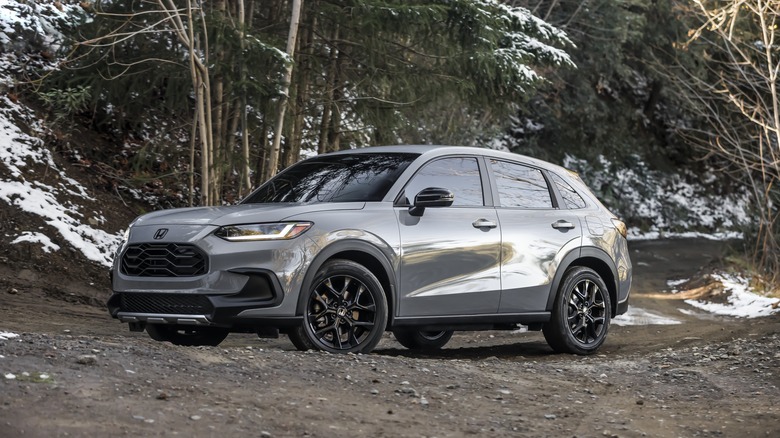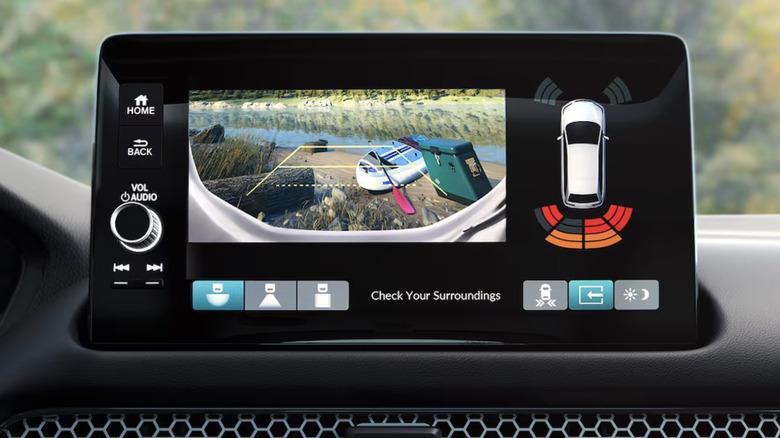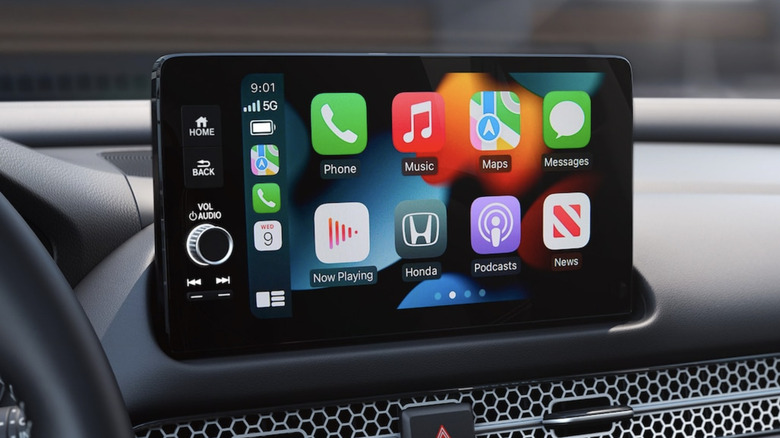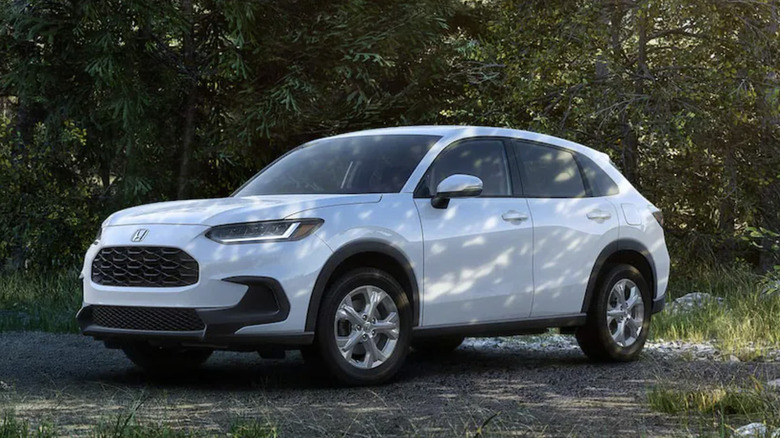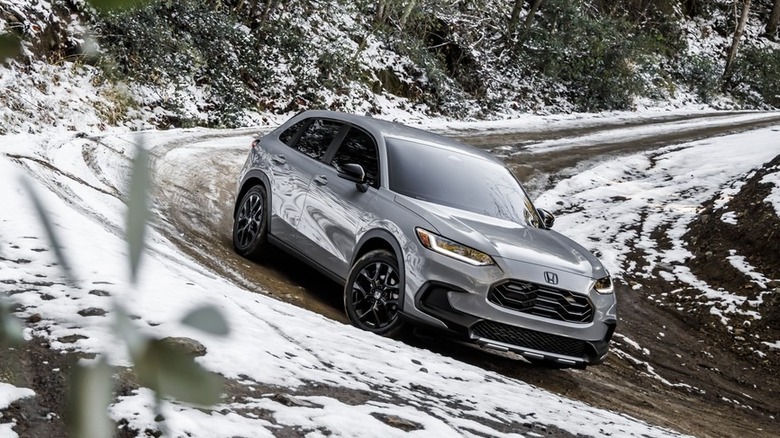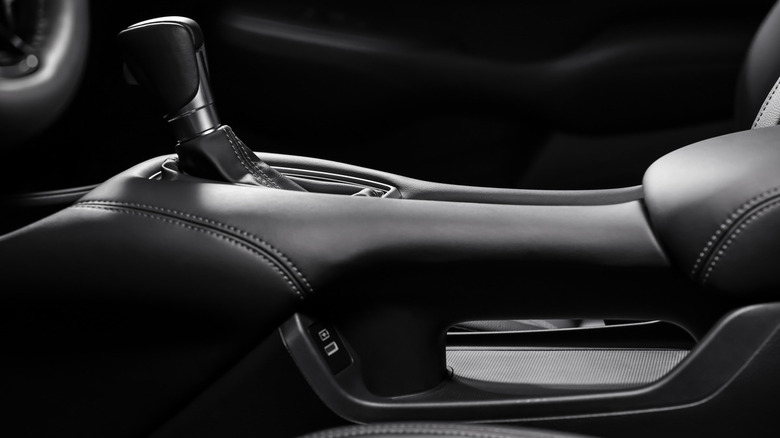5 Honda HR-V Features Worth Being Excited About
There's a lot to like about the Honda HR-V. It's a compact SUV that's refined, comfortable, and spacious enough for five people. The HR-V was last redesigned in 2023 with added power and new tech. Plus, it got a glow-up in the looks department, debuting with a style that's sleek, both inside and out.
The interior is built with lots of high-quality materials, and several stylish touches that were a big part of the latest Civic redesign make their way over to the HR-V, such as the honeycomb mesh that stretches across the dashboard and the hidden air vents. The 2025 HR-V is also relatively efficient — the EPA rates it at 28 mpg combined for front-wheel drive models and 27 mpg combined for all-wheel drive models.
Many features stand out and help the HR-V distinguish itself as a top contender among a crowded field of compact SUVs, but there are some minor details, things you might've missed, that are worth talking about, too. Tech features, trim levels, and an impressive list of accessories help the HR-V retain its appeal against the competition. But which HR-V features are the most exciting? Let's take a look.
Honda Sensing
The Honda Sensing suite of safety aids is an impressive package of modern tech that helps drivers and passengers feel more comfortable on the road. It provides a number of features that come as standard on the HR-V, giving it a sense of safety and security before you even step inside.
The Honda Sensing suite includes forward collision mitigation with automatic braking, road departure warning, and mitigation, adaptive cruise control with a low-speed follow function, and lane-keep assist. Upper trim levels add even more equipment. The Sport and EX-L trim feature blind-spot monitoring and a cross-traffic monitor, while the top-level EX-L adds low-speed braking control and front-and-rear parking sensors.
All trim levels feature a wide-view front camera, added to the current HR-V generation in 2023, that scans a 100-degree field of view. According to Honda, the system's field of view is twice as wide as the previous-gen HR-V's camera-and-radar system. It can recognize pedestrians, cyclists, and road boundaries like curbs or painted white road lines — all impressive features for a relatively basic SUV.
9-inch touchscreen
The previous generation of HR-V had two available touchscreens, and both were pretty small. The base model got a 5-inch touchscreen, while the upper trim levels got a 7-inch display. But with the current-generation HR-V, things are upgraded a bit. A 7-inch screen is now standard on both LX and Sport trim levels. The graphics are acceptable, and there are large buttons and knobs to help control the screen's functions if you don't want to rely solely on the touchscreen. The real party piece, though, is the 9-inch touchscreen.
Standard on the top-trim EX-L models, the 9-inch touchscreen has better graphics, and the larger display is easier to see from the driver's seat. The 9-inch screen gets wireless Apple CarPlay and Android Auto connectivity, an upgrade from the standard 7-inch system, which can only connect via USB. The larger screen also means access to SiriusXM satellite radio connectivity, and a wireless phone charging pad is included as part of the deal. To top it all off, the EX-L has an 8-speaker stereo system (double the standard speakers in the LX).
Basic LX trim with accessories
While topped-out trims like the HR-V EX-L are tempting (especially with impressive equipment like the 9-inch touchscreen), they aren't the right choice for everyone. For starters, the HR-V EX-L with all-wheel drive has a starting price of $32,050 (including destination), which isn't very budget-friendly.
If you're looking to get into a new SUV without spending as much, the base HR-V LX is a great place to look. The HR-V is appealingly inexpensive; with front-wheel drive, it starts at just $26,450 (including destination), which is the lowest price of any SUV in the Honda lineup and only slightly more expensive than the cheapest Civic ($25,045 including destination).
As previously mentioned, the base LX gets all the basic Honda Sensing features mentioned earlier, along with several accessories to choose from when customizing your HR-V. All-wheel drive is available on any trim level, including the LX so that you can have all-whether capability for a small fee. Then, there's the long list of dealer-installed features like roof racks, fender flares, special attachments for surfboards or kayaks, door visors, and even a tent that attaches to the back of the HR-V for all your camping needs. Just because it's inexpensive doesn't mean the most basic of HR-V's isn't versatile.
Hill descent control
The introduction of Hill Descent Control as a standard feature on the HR-V was a first for any Honda SUV. The system is activated by pressing and holding the brake pedal, then pressing the Hill Descent Control button on the center console. Then, once a speed (between 2-12 mph) is selected, the system allows the driver to remove their foot from the brake pedal, and the car takes over. The HR-V's brakes are then activated, keeping it at the pre-determined speed and allowing the driver to focus on steering. This system can be especially helpful in scenarios like an icy day when you have to go down your steep driveway. Or, if you've gone into the wilderness, Hill Descent Control can help there, too.
Sure, the HR-V isn't the first vehicle you expect to see when you're off-roading, and it certainly won't be seen conquering the Rubicon trail, but a bit of exploration off the beaten path isn't out of the question. The HR-V is available with all-wheel drive on every trim level (LX, Sport, and EX-L), which is helpful for drivers who live in rough-weather areas. The HR-V's three drive modes (Normal, Eco, and Snow) should also help deal with inclement weather. Put all this together, and you have a compact SUV that could explore some mildly challenging dirt roads without many issues.
Storage solutions
Honda is well known for its storage solutions. Over the years, their vehicles have included features like the Fit's magic flip-up folding seats, the Ridgeline's in-bed drainable trunk, and the multi-function removable seat in the latest-generation Pilot. The HR-V doesn't have any big, game-changing storage solutions, but it does have an impressive amount of cargo space and some clever cubbies.
Under the center console, there's a pass-through area that is accessible from the driver's side and the passenger's side. That area can easily store small items like a smartphone or a wallet, leaving your cupholders free for cups and bottles. In the pass-through, your smartphone is out of sight; having it out of sight means you're less likely to get distracted when it lights up with a notification. The HR-V's center console is also relatively large, allowing additional small-item storage. For the big stuff, the HR-V's rear seats fold down to open up 55.1 cubic feet of cargo storage. While that number isn't class-leading, there is plenty of space for a few large suitcases or camping gear.
